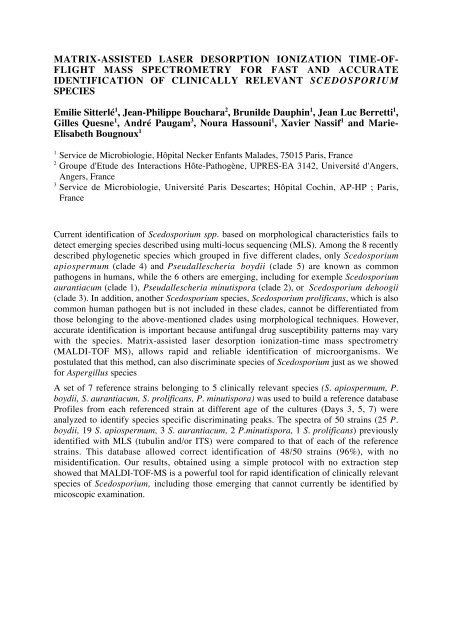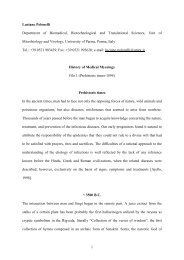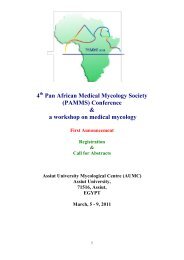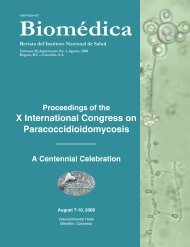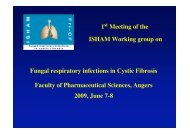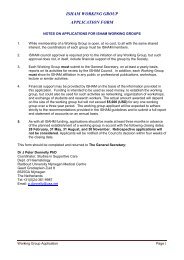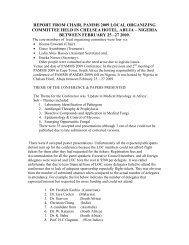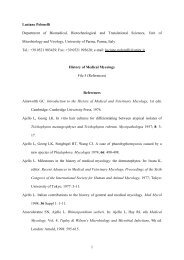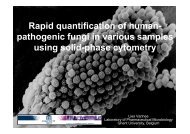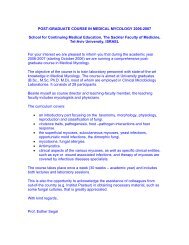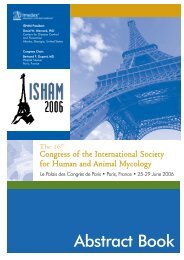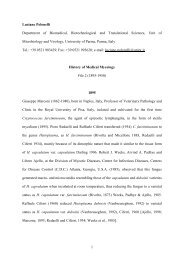Abstract book 2011 - ISHAM
Abstract book 2011 - ISHAM
Abstract book 2011 - ISHAM
Create successful ePaper yourself
Turn your PDF publications into a flip-book with our unique Google optimized e-Paper software.
MATRIX-ASSISTED LASER DESORPTION IONIZATION TIME-OF-FLIGHT MASS SPECTROMETRY FOR FAST AND ACCURATEIDENTIFICATION OF CLINICALLY RELEVANT SCEDOSPORIUMSPECIESEmilie Sitterlé 1 , Jean-Philippe Bouchara 2 , Brunilde Dauphin 1 , Jean Luc Berretti 1 ,Gilles Quesne 1 , André Paugam 3 , Noura Hassouni 1 , Xavier Nassif 1 and Marie-Elisabeth Bougnoux 11 Service de Microbiologie, Hôpital Necker Enfants Malades, 75015 Paris, France2 Groupe d'Etude des Interactions Hôte-Pathogène, UPRES-EA 3142, Université d'Angers,Angers, France3 Service de Microbiologie, Université Paris Descartes; Hôpital Cochin, AP-HP ; Paris,FranceCurrent identification of Scedosporium spp. based on morphological characteristics fails todetect emerging species described using multi-locus sequencing (MLS). Among the 8 recentlydescribed phylogenetic species which grouped in five different clades, only Scedosporiumapiospermum (clade 4) and Pseudallescheria boydii (clade 5) are known as commonpathogens in humans, while the 6 others are emerging, including for exemple Scedosporiumaurantiacum (clade 1), Pseudallescheria minutispora (clade 2), or Scedosporium dehoogii(clade 3). In addition, another Scedosporium species, Scedosporium prolificans, which is alsocommon human pathogen but is not included in these clades, cannot be differentiated fromthose belonging to the above-mentioned clades using morphological techniques. However,accurate identification is important because antifungal drug susceptibility patterns may varywith the species. Matrix-assisted laser desorption ionization-time mass spectrometry(MALDI-TOF MS), allows rapid and reliable identification of microorganisms. Wepostulated that this method, can also discriminate species of Scedosporium just as we showedfor Aspergillus speciesA set of 7 reference strains belonging to 5 clinically relevant species (S. apiospermum, P.boydii, S. aurantiacum, S. prolificans, P. minutispora) was used to build a reference databaseProfiles from each referenced strain at different age of the cultures (Days 3, 5, 7) wereanalyzed to identify species specific discriminating peaks. The spectra of 50 strains (25 P.boydii, 19 S. apiospermum, 3 S. aurantiacum, 2 P.minutispora, 1 S. prolificans) previouslyidentified with MLS (tubulin and/or ITS) were compared to that of each of the referencestrains. This database allowed correct identification of 48/50 strains (96%), with nomisidentification. Our results, obtained using a simple protocol with no extraction stepshowed that MALDI-TOF-MS is a powerful tool for rapid identification of clinically relevantspecies of Scedosporium, including those emerging that cannot currently be identified bymicoscopic examination.


